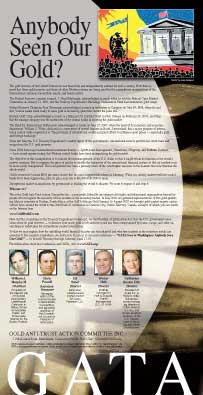You are here
Now even Reuters sounds like Jim Sinclair: 'QE to infinity'
Endless QE? $6 Trillion and Counting
By Mike Dolan
Reuters
Wednesday, June 13, 2012
http://www.reuters.com/article/2012/06/13/us-economy-qe-idUSBRE85C072201...
LONDON -- Many more years of money printing from the world's big four central banks now look destined to add to the $6 trillion already created since 2008 and may transform the relationship between the once fiercely-independent banks and governments.
As rich economies sink deeper into a slough of debt after yet another wave of euro financial and banking stress and U.S. hiring hesitancy, everyone is looking back to the U.S. Federal Reserve, European Central Bank, Bank of England, and Bank of Japan to stabilize the situation once more.
What's for sure is that quantitative easing, whereby the "Big Four" central banks have for four years effectively created new money by expanding their balance sheets and buying mostly government bonds from their banks, is back on the agenda for all their upcoming policy meetings.
... Dispatch continues below ...
Prophecy Platinum (TSXV:NKL) Announces Encouraging Rhodium, Ruthenium, Osmium,
Iridium Assays from WS11-188 of Wellgreen Project in Yukon Territory, Canada
Company Press Release
May 25, 2012
VANCOUVER, British Columbia, Canada -- Prophecy Platinum Corp. (TSX-V: NKL; OTC-QX: PNIKF; Frankfurt: P94P) is pleased to provide results of full spectrum 6E (Platinum, Palladian, Rhodium, Ruthenium, Osmium, and Iridium) analysis of platinum group elements on the first batch of samples from the company's wholly-owned Wellgreen PGM-Ni-Cu project in the Yukon Territory, Canada.
The company enlisted Activation Laboratories (Actlabs) of Ancaster, Ontario, to conduct a full-spectrum 6E analysis of samples taken from the 2011 drill hole WS11-188. Adding Rh, Ru, Os, and Ir to Pt and Pd increased the total PGE content (6E) by an average of 28 percent, based on a population of 90 samples, most of which are from disseminated sulphide-type mineralization.
Assay results with 6E exceeding 0.50 ppm (0.5 g/t) (excluding copper and gold assays) are tabulated at Prophecy's Internet site and are available with assay results from the entire batch of 90 samples here:
http://prophecyplat.com/news_2012_may25_prophecy_platinum_announces_rare...
Government credit cards are all but maxed out and commercial banks' persistent instability, existential fears, and reluctance to lend mean the explosion of newly minted cash has yet to spark the broad money supply growth needed to generate more goods and services.
In other words, electronic money creation to date -- whether directly through bond buying in the United States or Britain or in a more oblique form of cheap long-term lending by the ECB -- is not even replacing what commercial banks are removing by shoring up their own balance sheets and winding down loan books.
Global investors appear convinced that more QE is in the pipe.
"It is almost as if investors are saying QE will happen no matter what," said Bank of America Merrill Lynch's Gary Baker.
BoA Merrill's latest monthly survey of 260 fund managers showed nearly three in four expect the ECB to proceed with another liquidity operation by October. Almost half expected the Fed to return to the pumps over the same period.
The BoJ has already upped asset purchases yet again this year and Bank of England policy dove Adam Posen said on Monday the bank should not only buy more government bonds but target small business loans too.
But aside from investor hopes of a market-based call and response, is there any evidence that QE actually helps the underlying problem and what are the risks from all this?
The "counterfactual," to use an economics wonk's term, is the most powerful argument in QE's favor -- what would have happened if they didn't print at all and broad money supply collapsed?
But after four years in which, according to HSBC, the balance sheets of the Big Four have collectively more than tripled to $9 trillion and still not generated self-sustaining recoveries, the question is how long this can keep going on without creating bigger problems for the future.
For a start, there is no quick solution to the problem of mountainous indebtedness.
Recapitalizing banks; stabilizing housing and mortgage markets responsible for deteriorating loan quality; further deep integration of euro fiscal links to support the shared currency; and capping government debt piles in the United States, Japan, and Britain will -- even for optimists -- take many years.
On top of that the rich economies face gale force headwinds over the next decade from aging and retiring populations.
In the interim, the job of central banks looks increasingly like a blended mix of monetary policy and sovereign debt management. And that's on top of recently acquired roles as guardians of financial and banking system stability.
The concern is that monetary authorities are increasingly acting as government agents responsible as much for stabilizing bond markets and keeping banks clean as for fighting inflation.
The question is not whether central banks can withdraw this money again once broad money growth gains traction -- most think that's mechanically easy -- it's whether they will be able to resist pressure to carry on underwriting government deficits.
A series of papers prepared for a Bank for International Settlements workshop in May certainly saw the problem.
"Whatever view is taken of this, the boundary between monetary policy and government debt management has become increasingly blurred. Policy interactions have changed in ways that are difficult to understand," the BIS overview concluded.
The papers also made clear that this form of monetary policy has plenty of precedents throughout the earlier part of the 20th century during the gold standard. It's only since the 1980s and 1990s that consensus shifted squarely behind the idea of highly independent central banks pursuing narrow price stability and even strict inflation targets.
And given the level of credit chaos that ultimately emanated from the so-called Great Moderation, it's possible that history will see that system as the aberration rather than norm.
HSBC economists Karen Ward and Simon Wells reckon central bank independence is the biggest impact from ever-more QE and fear that, as in Japan, the price will be paid by persistently high if sustainable government deficits that stifle growth.
"The heyday of independent central banking could be drawing to a close," they wrote in a wide-ranging report on QE.
Hedge fund manager Stephen Jen said he thinks the temporary benefits of QE are outweighed by long-term costs such as removing pressure for fiscal reform and market volatility. "At some point," Jen said, "the benefit-cost balance flips."
Then again, not everyone bemoans the greater responsiveness of central banks to the will of elected governments.
"The source of central bank independence is public support from elected officials that the central bank is pursuing desirable social goals," BoE's Posen said Monday.
* * *
Join GATA here:
Standard Chartered's Earth Resources Conference
Wednesday-Thursday, June 20-21, 2012
J.W. Marriott, Hong Kong
http://www.standardcharteredsignatureevents.com/earths-resources/welcome...
Hong Kong Gold Investment Forum
Monday-Wednesday, June 25-27, 2012
Renaissance Harbour View Hotel, Hong Kong
http://www.hkgoldinvestmentforum.com/
Toronto Resource Investment Conference
Thursday-Friday, September 27-28, 2012
Toronto Sheraton Centre Hotel
Toronto, Ontario, Canada
http://www.cambridgehouse.com/event/toronto-resource-investment-conference
New Orleans Investment Conference
Wednesday-Saturday, October 24-27, 2012
Hilton New Orleans Riverside Hotel
New Orleans, Louisiana
http://www.neworleansconference.com/
* * *
Support GATA by purchasing DVDs of our London conference in August 2011 or our Dawson City conference in August 2006:
http://www.goldrush21.com/order.html
Or by purchasing a colorful GATA T-shirt:
Or a colorful poster of GATA's full-page ad in The Wall Street Journal on January 31, 2009:
http://gata.org/node/wallstreetjournal
Help keep GATA going
GATA is a civil rights and educational organization based in the United States and tax-exempt under the U.S. Internal Revenue Code. Its e-mail dispatches are free, and you can subscribe at:
To contribute to GATA, please visit:
Sona Discovers Potential High-Grade Gold Mineralization
at Blackdome in British Columbia -- 13.6g over 1.5 Meters
From a Company Press Release
November 22, 2011
VANCOUVER, British Columbia -- With its latest surface diamond drilling program at its 100-percent-owned, formerly producing Blackdome gold mine in southern British Columbia, Sona Resources Corp. has discovered a potentially high-grade gold-mineralized area, with one hole intersecting 13.6 grams of gold in 1.5 meters of core drilling.
"We intersected a promising new mineralized zone, and we feel optimistic about the assay results," says Sona's president and CEO, John P. Thompson. "We have undertaken an aggressive exploration program that has tested a number of target zones. Our discovery of this new gold-bearing structure is significant, and it represents a positive development for the company."
Sona aims to bring its permitted Blackdome mill back into production over the next year and a half, at a rate of 200 tonnes per day, with feed from the formerly producing Blackdome mine and the nearby Elizabeth gold deposit property. A positive preliminary economic assessment by Micon International Ltd., based on a gold price of $950 per ounce over eight years, has estimated a cash cost of $208 per tonne milled, or $686 per gold ounce recovered.
For the company's complete press release, please visit:
http://www.sonaresources.com/_resources/news/SONA_NR18_2011-opt.pdf








